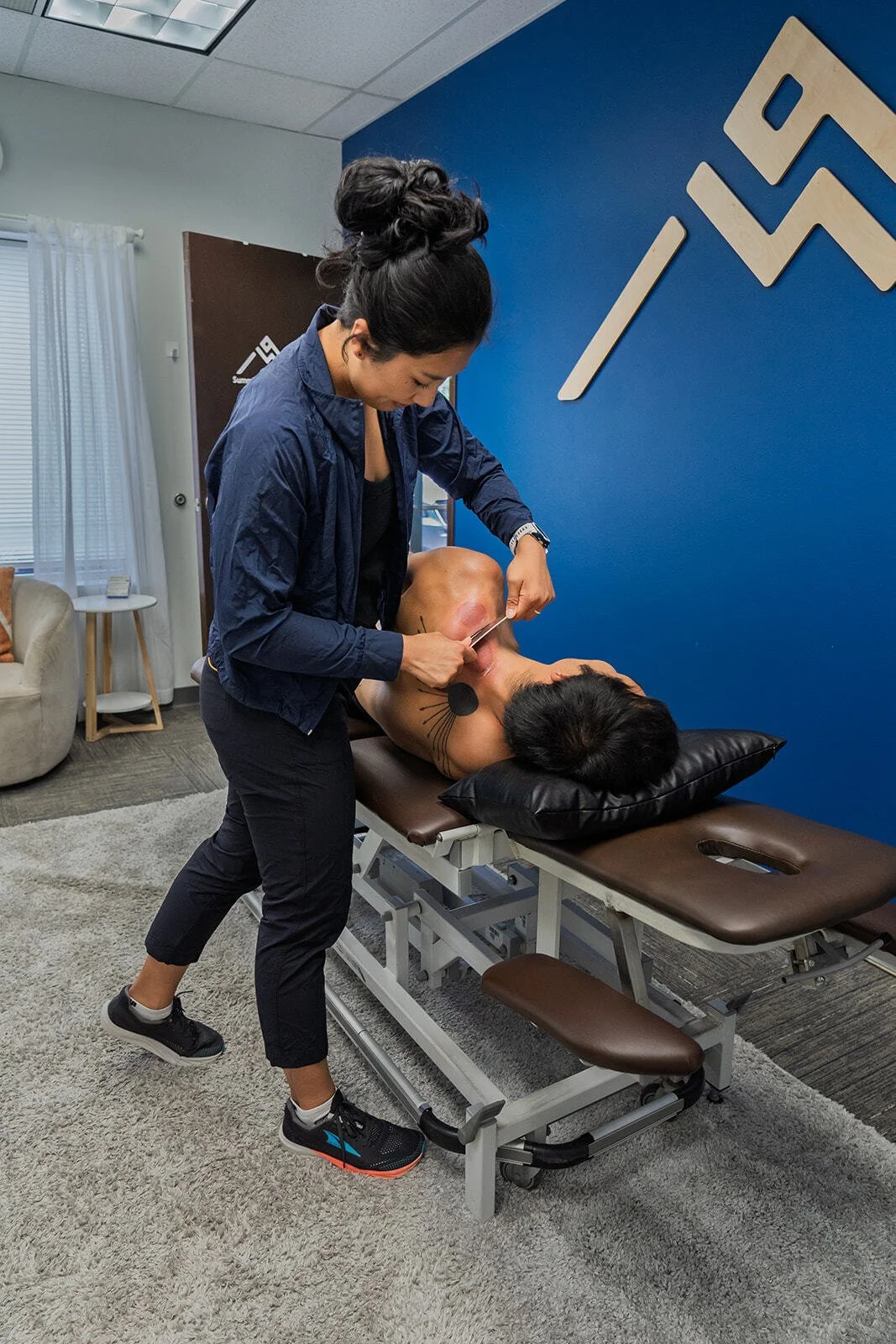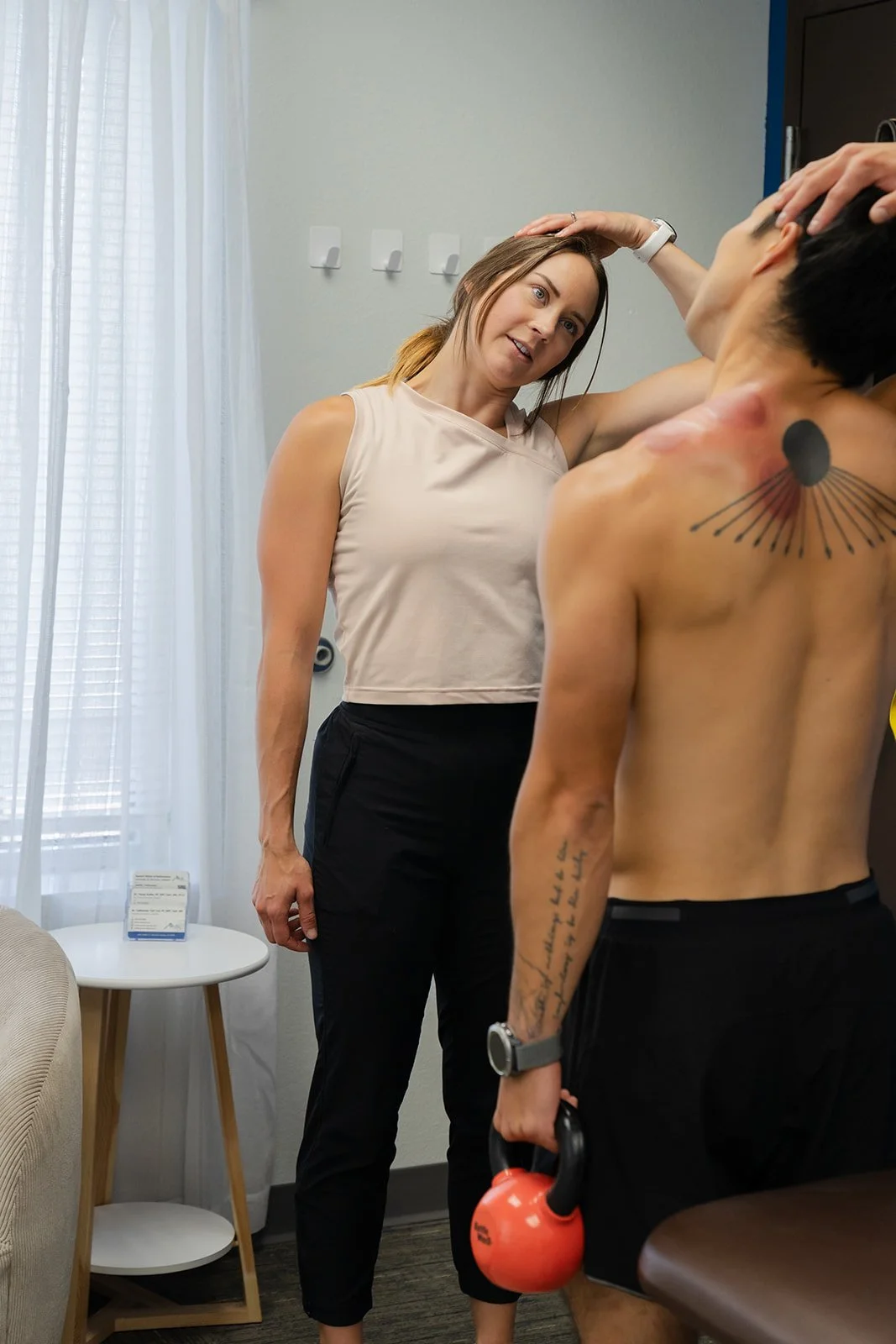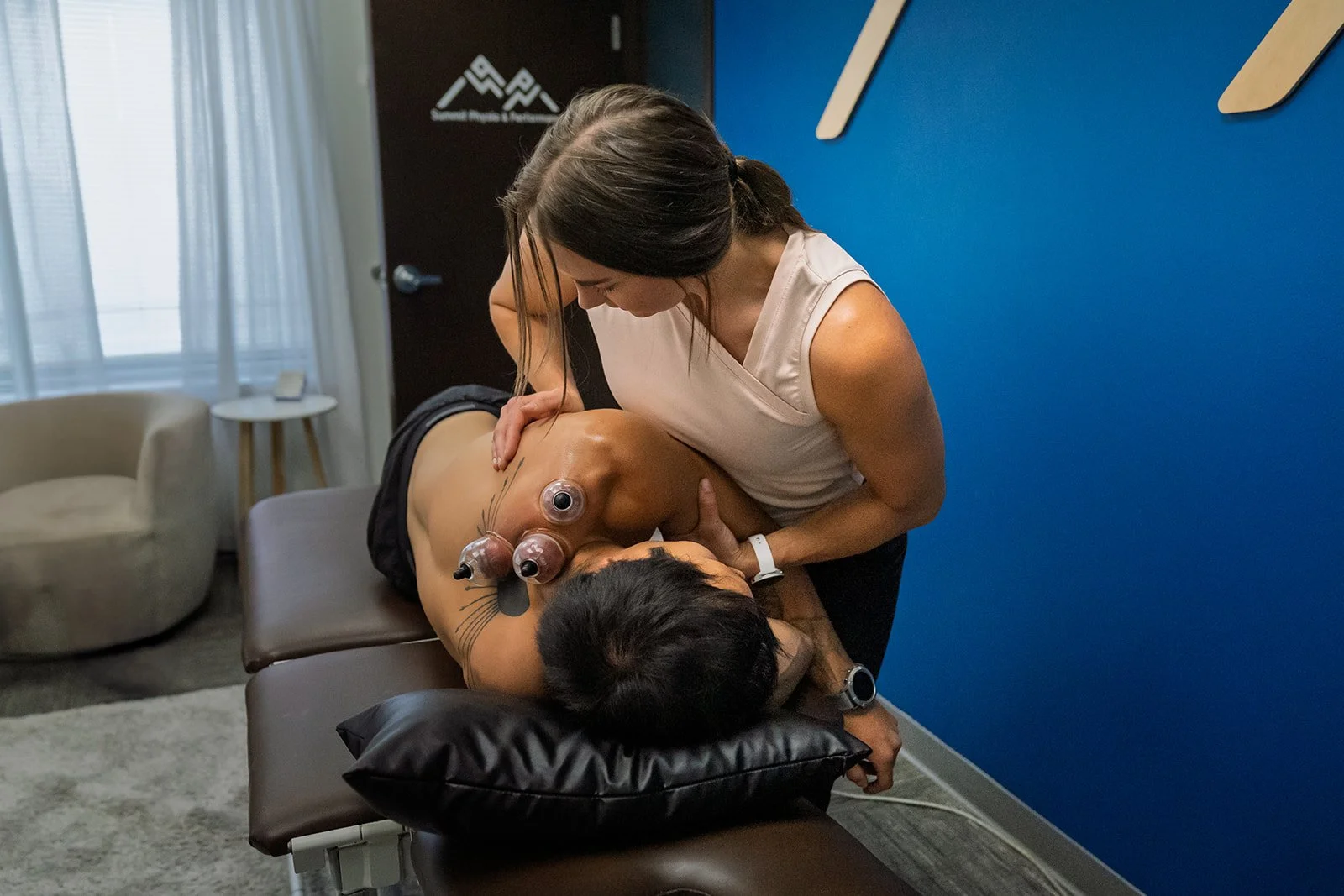Beyond the Bruises: How Cuptherapy Improves Movement and Recovery
INTRODUCTION
Cuptherapy, otherwise known as “cupping” and more formally known as myofascial decompression, has become increasingly common in sports and rehab settings, often used for recovery or to ease muscle tightness. But its effectiveness depends on how and why it’s applied. When integrated into an evidence-based plan and guided by clinical reasoning, cuptherapy can play a meaningful role in improving mobility, reducing discomfort, and helping you move and perform at your best.
Cuptherapy isn't just about creating suction; the way it’s applied and integrated into movement-based treatment is what makes it effective. Whether you’re dealing with stubborn tightness, lingering pain, or just looking to recover more efficiently, understanding how this technique works can help you make informed choices about your care. In this blog, we’ll walk through what myofascial decompression cupping actually does, how it works, and how a thoughtful approach can make it a valuable part of both rehab and performance programs.
What Is Myofascial Decompression Cuptherapy?
Myofascial decompression is a manual therapy technique that uses suction to create lift within the soft tissues of the body. By applying cups that draw the skin and fascia upward, this method helps decompress underlying structures, improve local circulation, and enhance tissue mobility. The goal is to restore the normal gliding motion between layers of fascia and muscle, allowing for smoother, more efficient movement and less restriction during activity.
The “myofascial” component refers to both the muscle (myo) and the connective tissue (fascia) that surround and support it. Over time, repetitive strain, injury, or immobility can lead to stiffness or limited motion in these layers. In contrast to other manual techniques that apply compressive force into the tissue, myofascial decompression works by lifting and decompressing it. This reversal of force creates space within restricted or adhered areas, allowing for improved gliding between fascial layers, better fluid exchange, and decreased mechanical stress. Depending on the amount of suction and tissue depth targeted, different levels of the fascia and muscle can be influenced. We can target superficial fascia, intramuscular fascia, lymphatics, and deep fascia specifically.
Lymphatics: the drainage system, important for normal recovery, after inflammation, infection, and for normal homeostasis - 40-150 mmHg
Superficial fascia: just below dermal (skin) surface - 100-250 mmHg
Intramuscular Fascia: fascia between the muscle fibers, allowing proper gliding of one fiber over another - 300-600 mmHg
Deep Fascia: the layer of fascia just above the epimysium, important for deeper glide of superficial tissues - 200-400 mmHg
How It Differs from Traditional Cupping
Traditional cupping has deep roots in many ancient healing systems, particularly Chinese, Middle Eastern, and Eastern European medicine. Historically, practitioners used hollowed-out animal horns or heated glass cups to create suction on the skin. This technique, sometimes referred to as fire cupping or wet cupping, could involve briefly heating the inside of the cup before application, or even lightly breaking the skin to draw out a small amount of blood.
Traditional cupping was, and still is, used to address a wide range of conditions, from respiratory illness and digestive issues to rheumatism and hormonal imbalance. In Chinese medicine, it’s believed to balance the flow of Qi (energy) throughout the body and help dispel stagnation that contributes to pain or disease.
Myofascial decompression cuptherapy builds on the mechanical principles of suction but applies them through a different lens, one grounded in modern anatomy, physiology, and movement science.
Rather than aiming to balance energy or address systemic health, it targets specific tissues and movement patterns identified during a clinical assessment. Both approaches share a similar foundation of using negative pressure to create change, but the intent and application are distinct.
How It Works
Cuptherapy works through three main mechanisms: the decompressive effect of negative pressure, the resulting changes in local fluid dynamics, and the neural input that influences pain and movement. Together, these three mechanisms promote improved tissue mobility, enhanced circulation, and a decrease in pain sensitivity.
Restoring Muscle Coordination
Many movement-related aches or performance limitations aren’t caused by a lack of strength alone but by how muscles coordinate and “fire” together. The body relies on complex communication between the brain, spinal cord, and muscles to create smooth, efficient motion. When one muscle group becomes overactive and another underactive, the system can lose its balance, leading to tightness, poor control, or recurring discomfort.
For example, think about someone who struggles to fully straighten their knee during the “up” phase of a squat because their hamstrings are over-active. By applying cups over the hamstrings, we can help them relax and reduce tension in that area. This change in muscle tone can make it easier for the quadriceps to activate and control movement more effectively.
Myofascial decompression cupping can help influence these neuromuscular patterns. By altering sensory input from the skin and fascia, cupping provides new feedback to the central nervous system (CNS), improving body awareness and facilitating more appropriate muscle recruitment. When paired with targeted movement retraining, this sensory feedback helps re-educate muscle firing patterns and restore coordinated movement, not just short-term relief.
Resetting the Nervous System
Cuptherapy also has a profound impact on the nervous system. When the cups lift the skin and fascia, they stimulate a variety of mechanoreceptors, specialized sensory nerves that detect stretch, pressure, and movement. These signals travel to the CNS, where they can help modulate pain and refine proprioception (the body’s sense of position and movement).
This process ties into the “gate control theory” of pain, where stimulation of large sensory fibers (A-beta nerves) can inhibit pain signals carried by smaller, slower fibers (A-delta and C fibers). In simpler terms: the sensory input from cupping can help “distract” the nervous system from pain and create a window of opportunity for better movement.
Beyond immediate perception changes, the decompressive stimulus may also influence muscle spindle and Golgi tendon organ activity, structures responsible for detecting changes in muscle length and tension. By modulating these systems, cupping can reduce protective muscle guarding and encourage a more natural, efficient movement response.
The Combined Mechanical and Neural Effects
Beyond sensory change, cuptherapy creates a distinct mechanical effect within the soft tissues. The decompressive lift helps bring fresh blood flow to areas of restriction, facilitating nutrient exchange and metabolic recovery. It can also decrease myofascial densification, the stiffening of fascia that limits tissue glide and improves the quality of movement through those regions.
Cuptherapy helps rehydrate and loosen the connective tissue, restoring the smooth gliding between fascial layers needed for efficient movement. This decompression can also assist in managing trigger points, reducing local tone in overly facilitated muscles, and influencing both peripheral and central nervous system activity in the short and potentially long term.
Ultimately, the combination of mechanical and neurophysiologic effects makes myofascial decompression a powerful complement to active movement retraining. The technique not only reduces pain and restriction but also supports the body in relearning optimal movement patterns, creating longer-lasting change rather than temporary relief.
What to Expect During a Myofascial Decompression Treatment at Summit Physio
Before starting, your physical therapist will identify specific areas of restricted tissue or movement limitations through thorough assessment. Once the target regions are determined, a thin layer of lotion is applied to the skin to allow smooth movement of the cups and to prevent irritation.
The cups are then applied using controlled suction to decrease decompression within the tissue. We typically begin with a short static hold, leaving the cups in place for a brief period to allow for tissue lift and decompression. This initial phase helps increase local circulation, reduce tissue density, and prepare the area for more active techniques.
We’ll use different cuptherapy techniques to achieve specific goals:
Static holds with joint movement: Keeping cups stationary while the patient moves through a range of motion (active or passive) to reinforce mobility gains.
You may be asked to move your limbs in specific directions or to perform strength exercises with the cups on.
Gliding: Moving the cup along the skin with reduced pressure to elongate restricted fascia or improve extensibility.
We typically will not leave cups on for more than 5-8 minutes. Once the cups are removed, your therapist may use instrument-assisted soft tissue mobilization (IASTM), sometimes called scraping, to help flush out the area. This technique uses specially designed tools to promote fluid movement, enhance blood flow, and further reduce tissue density. It’s often used to complement decompression by reinforcing the improved mobility and circulation achieved during the session.
What to Expect After Cuptherapy
After a cuptherapy session, it’s common to notice visible changes in the skin which can range from light redness to deeper color changes or even mild swelling. These are normal responses to the decompression forces acting on the tissues and are part of how your body adapts and heals.
When the cup creates negative pressure, it draws the skin and fascia upward, separating the layers and improving fluid exchange. The areas closest to the rim of the cup experience the most compressive force, while the space just inside that rim feels the strongest decompression. These opposing forces stimulate local circulation, promote lymphatic flow, and help restore tissue mobility.
You might notice dimpling of the skin, increased texture or thickening, or even areas that feel spongy or raised immediately after treatment. These are often indicators that we’ve targeted regions with denser or more viscous ground substance, tissue that tends to feel “stuck.” When decompressed, these areas can experience improved porosity and glide between layers.
Unlike in traditional Eastern medicine, we don’t interpret post-treatment color as diagnostic or prognostic. The appearance of darker marks simply reflects local circulatory response, not toxicity or stagnation, and typically fades within several days.
Mild soreness or tenderness for 24–48 hours afterward can be normal, especially in areas that were previously restricted. However, patients typically describe an immediate sense of looseness, improved range of motion, or easier movement following the session.
Additionally, to achieve the most effective cuptherapy treatment, we recommend loading, performing strength- and mobility-based exercises prescribed by your physical therapist after the session for best results. Strengthening and performing mobility exercises after cuptherapy can help achieve lasting results and teaches the body how to use the increased range of motion and mobility.
Is Cuptherapy Right for You?
Cuptherapy can be a valuable tool for a wide range of patients, from competitive athletes looking to move and recover better, to individuals managing pain, tightness, or mobility limitations that don’t seem to go away with stretching alone. While it’s often associated with recovery, its benefits go far beyond relaxation or temporary relief.
Cuptherapy may be appropriate for you if you experience:
Muscle tightness or tension that limits movement or performance.
Chronic overuse symptoms such as Achilles or patellar tendinopathy, IT band irritation, or shoulder impingement.
Myofascial restrictions that make movements like squatting, overhead pressing, or running feel “stuck” or restricted.
Post-injury stiffness or adhesions following sprains, strains, or immobilization.
Altered movement patterns or compensations—for example, relying on one side of your body to do all the work—can cause strain and limit performance.
Delayed recovery after high training volumes or competition.
Nerve-related tension or hypersensitivity that benefits from improved soft-tissue glide.
Pain that changes with movement rather than constant pain at rest (a key sign that mechanics, not just inflammation, are involved).
Because cuptherapy works through decompression, it can be especially useful when traditional deep-tissue or compressive manual techniques feel too aggressive or ineffective. It provides a way to influence tissue mobility and the nervous system without adding more pressure to an already irritated area.
At Summit Physio, we rarely use cuptherapy as a stand-alone treatment. Instead, it’s part of a multimodal approach, integrated with corrective exercise, other manual techniques which may include dry needling, mobilization, manipulation, or soft tissue work, or in conjunction with load management, and movement retraining. The goal isn’t just to make things feel better temporarily, but to restore how your body moves and performs long-term.
Want to see if Cuptherapy is right for you? Text the word “consultation” to (719) 419-8833 and we’d be happy to answer your questions!
Dr. Cat Cui, PT, DPT








